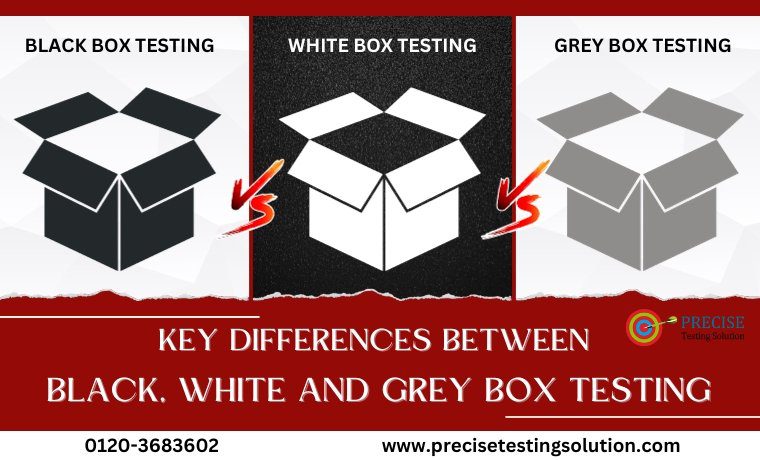What is Testing?
Testing is a systematic review of a software product or service to see whether it complies with documentation, specifications, and other sorts of available information. Different systems are tested using a variety of testing techniques for which it is classified into 3 main categories namely, black, white and grey box testing under diverse circumstances. In this blog post, we’ll discuss the major differences between these 3-software testing methodologies.
Let’s Begin!
Black Vs. White Vs. Grey Box Testing
The following is a table-based comparison to understand the key differences between black, white and grey box testing:
| Black Box Testing | White Box Testing | Grey Box Testing |
| For this kind of testing, it is not necessary to have any knowledge of the internal workings of the software. | For this kind of testing, it is necessary to have knowledge of internal workings of the software. | For this kind of testing, it is necessary to have some knowledge of internal workings of the software. |
| Additional names for black box testing include functional testing, data-driven testing, and closed box testing. | There are several other names for white box testing, including structural testing, clear box testing, code-based testing, and transparent testing. | The term “grey box testing” or “translucent testing” refers to testing where the tester has only rudimentary coding skills. |
| Since, the testers are not required to understand the internal software coding, this testing methodology comprises trial and error methods. | Since there is no internal coding knowledge disparity, White Box Testing is followed by a verification of the system boundaries and data domains built into the software. | The software is next validated for its internal system boundaries and data domains if the tester has coding skills in this software testing methodology. |
| The largest of all testing spaces is the testing area for input tables, which include the inputs needed to build test cases. | In comparison to Black Box testing, there is less testing area for input tables (inputs used to create test cases). | In contrast to Black Box and White Box testing, the testing space for input tables (the inputs used to create test cases) is smaller in case of Gray Box testing. |
| Finding hidden software flaws is exceedingly challenging because they may result from internal workings that Black Box testing cannot access. | Due to the possibility that they may result from internal functioning, which is thoroughly examined in White Box testing, hidden faults are easily found. | It is challenging to find the hidden fault. Potentially discovered in grey box testing. |
| The amount of time needed for Black Box testing relies on whether the functional specifications are available. | Due to the extensive code, designing test cases for white box testing takes a lot of time. | Utilising this software testing methodology allows test case design to be completed quickly. |
| Testers, developers, and end users can all participate in this type of software testing methodology. | The end user cannot participate in this type of testing; only testers and developers may. | Testing might involve testers, developers, and end users in this type of software testing methodology. |
| Of all the testing methodologies, it takes the least amount of time. | The testing process takes the most time of all the testing techniques. | It is a quicker process as compared to White Box testing. |
| Black Box testing addresses security threats against cyber-attacks. | White Box testing doesn’t address security threats against cyber-attacks. | Grey Box testing doesn’t address security threats against cyber-attacks. |
| The internal behaviour is unknown; hence this testing is based on exterior expectations. | Coding, which oversees internal operation, serves as the foundation for this testing. | High-level database and dataflow diagrams are used for this type of software testing methodology. |
Conclusion
Hence, from the above discussion, we can conclude this blog post by saying that the most difficult part is understanding when to apply each of these techniques, but keep in mind that they are all essential to the software testing process. White box testing works well when you want to make sure that all code paths are covered, but black box testing is better suited for testing the functionality of the software. When you want to examine both the internal and outward workings of the software, grey box testing sits somewhere in the centre. I hope this blog post has clarified things for you and will assist direct your future work.
Contact Precise Testing Solution if you need assistance deciding on the best testing strategy for your project, and we’ll make sure that no errors get through in your software product!
For more information, visit our website at www.precisetestingsolution.com or call our office @ 0120-3683602
Also, you can send us an email at [email protected]
We look forward to helping you.
How to Identify Email Spoofing Attempts
What Is The History Of Spoofing Spoofing, in the
A Comprehensive Guide to Optimizing Your A/B Testing
What is A/B testing? Also known as split A/B



